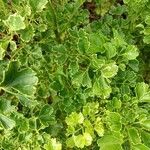Shrubs or treelets, to 5 m tall, andromonoecious. Leaves 1-pinnate (irregularly decompound or 2-or 3-pinnate in some forms); petiole 7-18 cm, clasping at base, alate for 1.5-3 cm with membranous wings; petiolules 1-3.5 cm; leaflets (5-)7-9, often variegated, elliptic, ovate, or obovate, often broadly so, 5-20 × 2.5-12 cm, papery, base broadly cuneate to attenuate, margin spinulose-serrate, teeth (1-)1.5-5 mm, apex obtuse to broadly acute or acuminate. Inflorescence terminal, pendent, a panicle of umbels; primary axis 3-6 cm; secondary axes 5-10, scattered toward base, upper ones forming a terminal umbel, 20-60 cm; tertiary axes 8-12 per secondary axis, grouped in 1-3 ver-ticils, (1.5-)3-12 cm; peduncles 1-2 cm, with a terminal umbel of bisexual flowers and often 1(or 2) lateral umbels of staminate flowers; pedicels 4-10 mm. Ovary 3-or 4(or 5)-carpellate; styles free nearly to base, recurving in fruit. Fruit rarely seen, subglobose, 4-5 mm high.
A shrub. It grows 2-5 m high. The leaflets are oval and have weak teeth along the edge. The leaves are dark green or yellow and have white along the edges. The leaf blades vary in shape.

